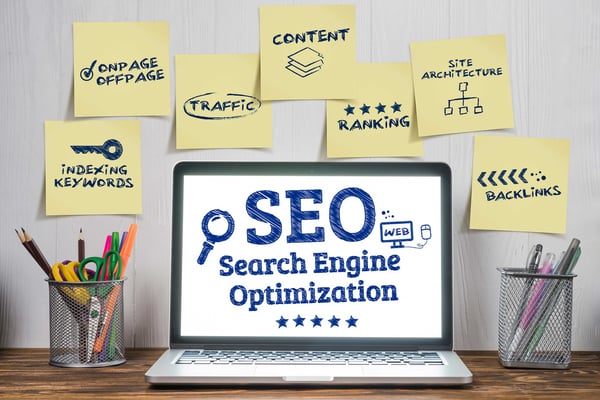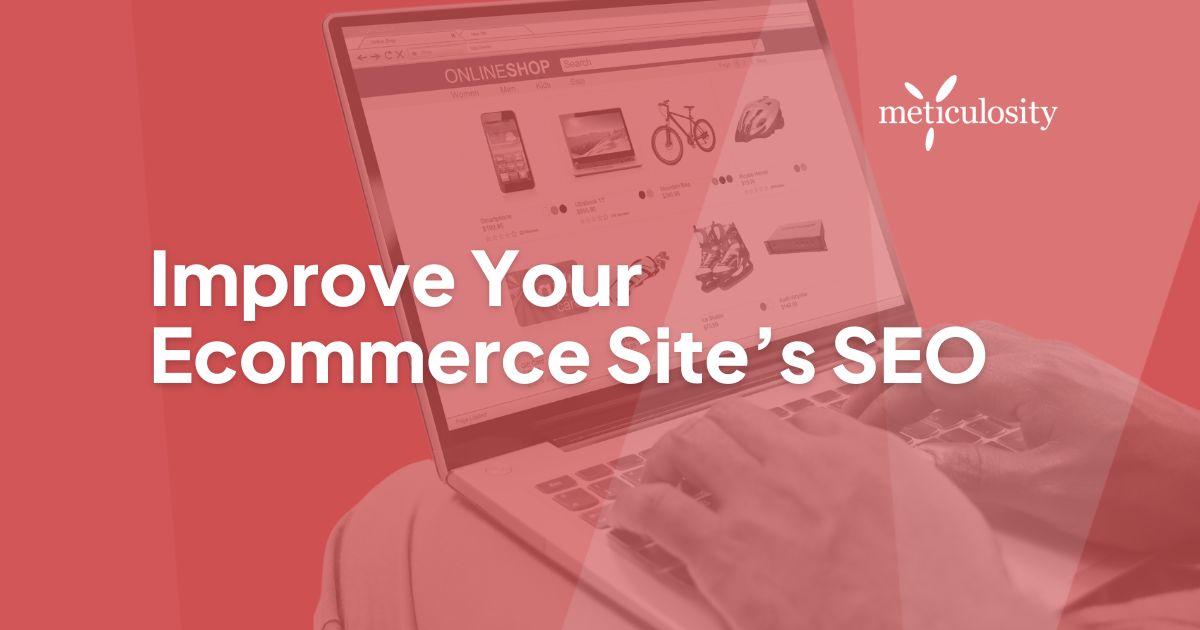Billions of people use search engines daily. That’s almost a trillion searches every year!
Today, search engines are available at our fingertips on our phones, tablets, laptops, and smart home devices with cloud-based intelligent voice services such as Google Home or Alexa Echo.

Online search traffic is a free and organic way to drive your ecommerce business forward. Take advantage of that! Search engines utilize algorithms to select high-quality sources for their top results.
While moving up the ranks takes time, it’s well worth optimizing your site. Appearing in the top results of trusted search engine sites like Google immediately shows customers you are worth looking at.
5 Steps to Improving Your SEO
A beautifully designed website is wonderful, but the design is meaningless if your customers can’t find it. Once your customers know your site, ensuring they can easily reach your products without frustration is important. Improve your Search Engine Optimization for your eCommerce business with the following five steps.
1. Optimize High Impact Pages
Identify and highlight your key eCommerce pages. Ensure that those high-impact pages have strong keywords, search engine-friendly URLs (keep them short and uncomplicated), as well as unique metadata titles and descriptions. Titles should be no longer than 60 characters, and descriptions should be about 160 characters.
2. Maximize Product Pages
Descriptions: Your product pages should feature descriptions with information that is different from your competitors and long-tail keywords that are usually 4-5 words long. These are often used by people searching for specific information; they are more likely to be ready to make a purchase.
Keep out-of-stock product pages live: Use them as opportunities to invite customers to sign up for email notifications once the product is back in stock. This keeps the customer engaged and looped into your eCommerce business offerings.
Search engines reward sites for having content-rich reviews: Encourage and feature customer reviews on your site. 92% of people trust recommendations from friends and family over any other type of advertising, as reported by Nielsen.
3. Strategic Internal Linking
On your product pages, make sure to feature related products. Linking the products encourages search engine crawlers through the website, creating a sort of “breadcrumb trail,” taking it from one page to the next. However, be careful with the number of links featured on your pages. Too many links are negative and can hurt your SEO as the linking appears artificial.
4. Improve Usability
Nothing hurts sales conversions and SEO like usability. 70-90% of customers use mobile devices. Make sure your site is dynamic, and review the quality of your content. It needs to be easy to read on the go with easy-to-follow navigation. Features like a search bar, live chat widget, and solid page load speed create a pleasant site experience. Better yet, these are features that search engines reward when reviewing sites for search engine ranking.
5. Prioritize Blogging
Use it as a platform. Generate backlinks and links to products in your blog posts. This keeps your site active and gives search engines new, quality content to crawl.
Invite influencers to create guest blog posts and share them across their platforms. This creates another rewarding opportunity in Search Engine Optimization, showing sites like Google that your website has the most authoritative, current, and useful information.

Maintain Your High SEO Performance
Now that you’ve made the necessary adjustments to boost traffic to your site and position your eCommerce business for increased conversions don’t forget about maintenance.
Search engine algorithms change all the time. Keep abreast of the latest updates and adjust your site accordingly. Subscribe to the latest news, podcasts, and email updates, and reference your team of digital marketing experts.
Look for and avoid duplicate content. Duplicate content happens naturally! There may be a point you want to drive home to your consumers, and it ends up featured in multiple places on your site. That, however, can hurt your SEO. Run quick regular audits to rework or remove duplicates.
Make it easy for search engines to crawl your site. Use an XML sitemap generator to make it easy for search engines like Google to visually see how and where your pages are on the site. XML sitemaps layout all of your URLs, giving your site a little bit of a boost when crawlers identify what to pull into search engine results.
Keep it simple. Most importantly, keep your site straightforward and simple. Less is more! Remove the barriers for both customer and search engine crawlers. For example, frustration from a difficult checkout process will impact your conversion and increase your bounce rate. Keep your HTML code clean. Messy code affects how well crawlers can navigate through your site.
Your website is the centerpiece of all your marketing activities and should be your best salesperson. The way firms have traditionally approached website design has a great deal of systemic risk and wasted opportunity. Instead, make your website an asset! Meticulosity uses Growth Driven Design to constantly improve and maintain your site to ensure that it always speaks the right message to the right visitor at the right time.
Meticulosity marries form with function. Every site needs to look good, but it also needs to work. That's why we keep design and development as different functions: programmers are bad designers, and designers are bad programmers.
FAQs
1. How crucial is SEO for an eCommerce site's success?
SEO is paramount for eCommerce success. It enhances visibility, attracts targeted traffic, and boosts your site's ranking on search engines, ultimately driving more sales.
2. What are the key SEO strategies for eCommerce sites?
Optimize product pages with relevant keywords, create unique and compelling product descriptions, implement a user-friendly site structure, and focus on building high-quality backlinks.
3. How can I enhance the site speed of my eCommerce platform?
Optimize images, leverage browser caching, and invest in reliable hosting. Implement a content delivery network (CDN) and regularly audit and compress website elements for optimal performance.
4. Is mobile optimization essential for eCommerce SEO?
Absolutely. Mobile optimization is crucial with a growing number of users accessing eCommerce sites via mobile devices. Ensure responsive design, easy navigation, and a seamless mobile shopping experience.







